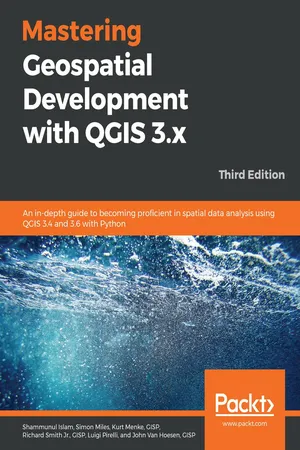
Mastering Geospatial Development with QGIS 3.x
An in-depth guide to becoming proficient in spatial data analysis using QGIS 3.4 and 3.6 with Python, 3rd Edition
- 466 pages
- English
- ePUB (mobile friendly)
- Available on iOS & Android
Mastering Geospatial Development with QGIS 3.x
An in-depth guide to becoming proficient in spatial data analysis using QGIS 3.4 and 3.6 with Python, 3rd Edition
About This Book
Go beyond the basics and unleash the full power of QGIS 3.4 and 3.6 with practical, step-by-step examples
Key Features
- One-stop solution to all of your GIS needs
- Master QGIS by learning about database integration, and geoprocessing tools
- Learn about the new and updated Processing toolbox and perform spatial analysis
Book Description
QGIS is an open source solution to GIS and widely used by GIS professionals all over the world. It is the leading alternative to proprietary GIS software. Although QGIS is described as intuitive, it is also, by default, complex. Knowing which tools to use and how to apply them is essential to producing valuable deliverables on time.
Starting with a refresher on the QGIS basics and getting you acquainted with the latest QGIS 3.6 updates, this book will take you all the way through to teaching you how to create a spatial database and a GeoPackage. Next, you will learn how to style raster and vector data by choosing and managing different colors. The book will then focus on processing raster and vector data. You will be then taught advanced applications, such as creating and editing vector data. Along with that, you will also learn about the newly updated Processing Toolbox, which will help you develop the advanced data visualizations. The book will then explain to you the graphic modeler, how to create QGIS plugins with PyQGIS, and how to integrate Python analysis scripts with QGIS.
By the end of the book, you will understand how to work with all aspects of QGIS and will be ready to use it for any type of GIS work.
What you will learn
- Create and manage a spatial database
- Get to know advanced techniques to style GIS data
- Prepare both vector and raster data for processing
- Add heat maps, live layer effects, and labels to your maps
- Master LAStools and GRASS integration with the Processing Toolbox
- Edit and repair topological data errors
- Automate workflows with batch processing and the QGIS Graphical Modeler
- Integrate Python scripting into your data processing workflows
- Develop your own QGIS plugins
Who this book is for
If you are a GIS professional, a consultant, a student, or perhaps a fast learner who wants to go beyond the basics of QGIS, then this book is for you. It will prepare you to realize the full potential of QGIS.
Frequently asked questions
Information
Section 1: Introduction
- Chapter 1, A Refreshing Look at QGIS
A Refreshing Look at QGIS
- Downloading QGIS and its installation
- The QGIS graphical user interface
- Loading data
- Working with coordinate reference systems (CRS)
- Working with tables
- Editing data
- Styling data
- Composing a map
- Finding and installing plugins
Release schedules
QGIS downloading and installation
Installing QGIS on Windows
- QGIS Standalone Installer: The standalone installer installs the binary version of QGIS and the Geographic Resource Analysis Support System (GRASS) using a standard Windows installation tool. You should choose this option if you want an easy installation experience of QGIS. This is also the ideal installation method for organizations or businesses wishing to deploy QGIS to multiple users.
- OSGeo4W Network Installer: This provides you with the opportunity to download either the binary or source code version of QGIS, as well as experimental releases of QGIS. Additionally, the OSGeo4W installer allows you to install other open source tools and their dependencies.
Installing QGIS on macOS
Installing QGIS on Ubuntu Linux
Installing QGIS only
deb http://qgis.org/debian trusty main deb-src http://qgis.org.debian trusty main
sudo apt-get update sudo apt-get install qgis python-qgis
sudo apt-get install qgis-plugin-grass
Installing QGIS and other FOSSGIS packages
sudo apt-get install python-software-properties sudo add-apt-repository ppa:ubuntugis/ubuntugis-unstable sudo apt-get update sudo apt-get install qgis python-qgis qgis-plugin-grass
QGIS on Android
Table of contents
- Title Page
- Copyright and Credits
- About Packt
- Contributors
- Preface
- Section 1: Introduction
- A Refreshing Look at QGIS
- Section 2: Getting Started
- Styling Raster and Vector Data
- Creating Spatial Databases
- Preparing Vector Data for Processing
- Preparing Raster Data for Processing
- Section 3: Diving Deeper
- Advanced Data Creation and Editing
- Advanced Data Visualization
- Section 4: Becoming a Master
- The Processing Toolbox
- Automating Workflows with the Graphical Modeler
- Creating QGIS Plugins with PyQGIS and Problem Solving
- PyQGIS Scripting
- Other Books You May Enjoy